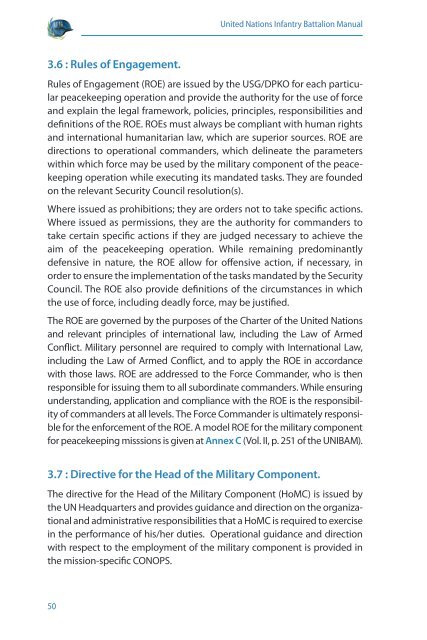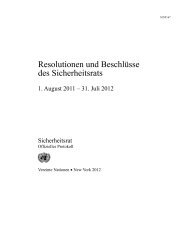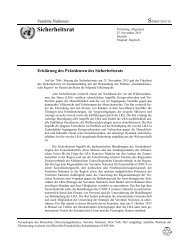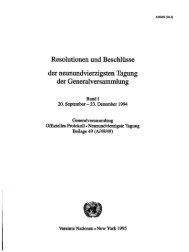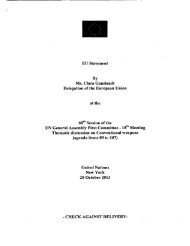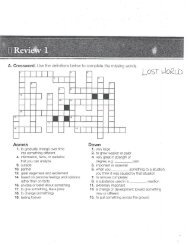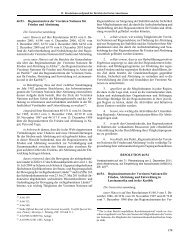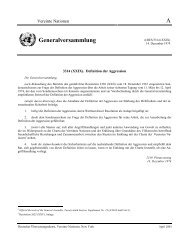United Nations Infantry Battalion Manual - the United Nations
United Nations Infantry Battalion Manual - the United Nations
United Nations Infantry Battalion Manual - the United Nations
You also want an ePaper? Increase the reach of your titles
YUMPU automatically turns print PDFs into web optimized ePapers that Google loves.
3.6 : Rules of Engagement.<br />
50<br />
<strong>United</strong> <strong>Nations</strong> <strong>Infantry</strong> <strong>Battalion</strong> <strong>Manual</strong><br />
Rules of Engagement (ROE) are issued by <strong>the</strong> USG/DPKO for each particular<br />
peacekeeping operation and provide <strong>the</strong> authority for <strong>the</strong> use of force<br />
and explain <strong>the</strong> legal framework, policies, principles, responsibilities and<br />
definitions of <strong>the</strong> ROE. ROEs must always be compliant with human rights<br />
and international humanita ri an law, which are superior sources. ROE are<br />
directions to operational commanders, which delineate <strong>the</strong> parameters<br />
within which force may be used by <strong>the</strong> military component of <strong>the</strong> peacekeeping<br />
operation while executing its mandated tasks. They are founded<br />
on <strong>the</strong> relevant Security Council resolution(s).<br />
Where issued as prohibitions; <strong>the</strong>y are orders not to take specific actions.<br />
Where issued as permissions, <strong>the</strong>y are <strong>the</strong> authority for commanders to<br />
take certain specific actions if <strong>the</strong>y are judged necessary to achieve <strong>the</strong><br />
aim of <strong>the</strong> peacekeeping operation. While remaining predominantly<br />
defensive in nature, <strong>the</strong> ROE allow for offensive action, if necessary, in<br />
order to ensure <strong>the</strong> implementation of <strong>the</strong> tasks mandated by <strong>the</strong> Security<br />
Council. The ROE also provide definitions of <strong>the</strong> circumstances in which<br />
<strong>the</strong> use of force, including deadly force, may be justified.<br />
The ROE are governed by <strong>the</strong> purposes of <strong>the</strong> Charter of <strong>the</strong> <strong>United</strong> <strong>Nations</strong><br />
and relevant principles of international law, including <strong>the</strong> Law of Armed<br />
Conflict. Military personnel are required to comply with International Law,<br />
including <strong>the</strong> Law of Armed Conflict, and to apply <strong>the</strong> ROE in accordance<br />
with those laws. ROE are addressed to <strong>the</strong> Force Commander, who is <strong>the</strong>n<br />
responsible for issuing <strong>the</strong>m to all subordinate commanders. While ensuring<br />
understanding, application and compliance with <strong>the</strong> ROE is <strong>the</strong> responsibility<br />
of commanders at all levels. The Force Commander is ultimately responsible<br />
for <strong>the</strong> enforcement of <strong>the</strong> ROE. A model ROE for <strong>the</strong> military component<br />
for peacekeeping misssions is given at Annex C (Vol. II, p. 251 of <strong>the</strong> UNIBAM).<br />
3.7 : Directive for <strong>the</strong> Head of <strong>the</strong> Military Component.<br />
The directive for <strong>the</strong> Head of <strong>the</strong> Military Component (HoMC) is issued by<br />
<strong>the</strong> UN Headquarters and provides guidance and direction on <strong>the</strong> organizational<br />
and administrative responsibilities that a HoMC is required to exercise<br />
in <strong>the</strong> performance of his/her duties. Operational guidance and direction<br />
with respect to <strong>the</strong> employment of <strong>the</strong> military component is provided in<br />
<strong>the</strong> mission-specific CONOPS.


